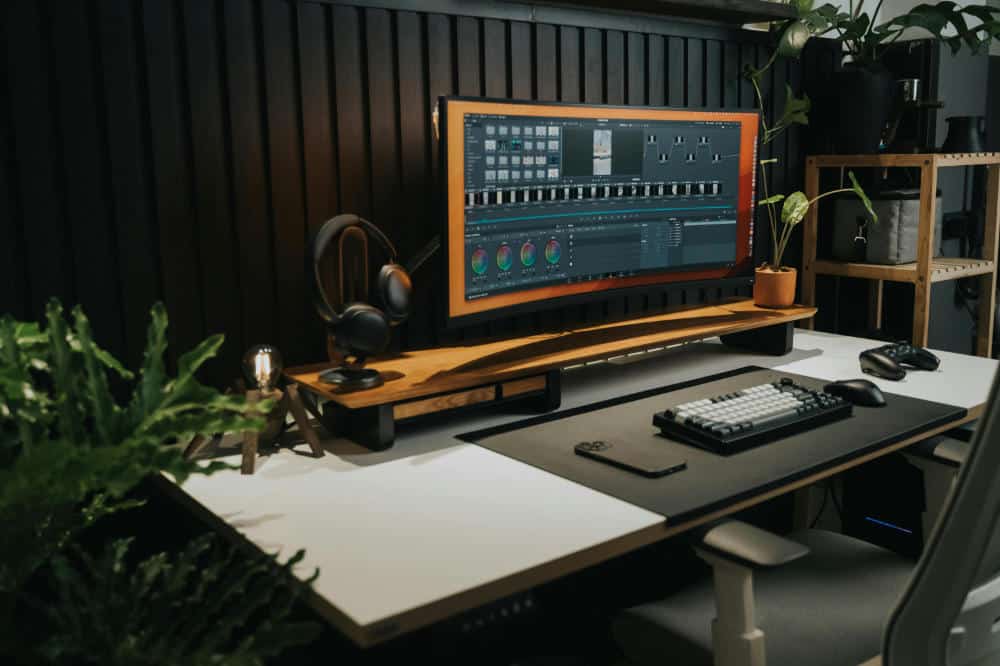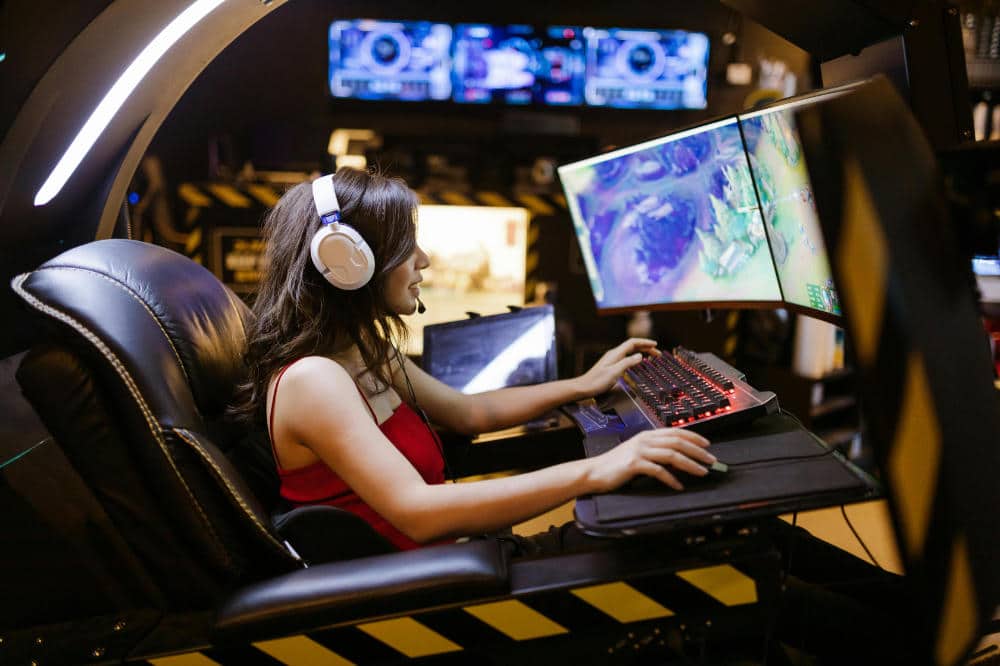Estimated reading time: 8 minutes
Are you struggling to find the perfect monitor for your music production setup? The right display can make or break your creative process, impacting everything from your workflow to the final sound quality. But with so many options on the market, how do you choose the best monitor for music production?
From size and curvature to resolution and color accuracy, the choices can be overwhelming. You might be wondering: Do I really need a curved monitor? Is bigger always better? What about those trendy ultrawide displays? Don’t worry – we’ve got you covered. In this guide, we’ll dive deep into the world of music production monitors, exploring the key factors that matter most to producers and audio engineers.
Get ready to discover the answers to these burning questions and more as we explore the four essential aspects of choosing your ideal music production monitor: size requirements, the curved vs. flat debate, the ultrawide phenomenon, and other crucial considerations. By the end of this post, you’ll be equipped with the knowledge to make an informed decision and take your music production setup to the next level. Let’s dive in!

Table of contents
What size monitor do I need?
When it comes to choosing the right monitor size for music production, there are several factors to consider. The ideal size depends on your workspace, workflow, and personal preferences. Here’s a breakdown of popular monitor sizes and their benefits:
Monitor Size Comparison
| Size (inches) | Pros | Cons |
|---|---|---|
| 24-27 | Affordable, space-efficient | Limited screen real estate |
| 32 | Good balance of size and detail | May require more desk space |
| 34+ (Ultrawide) | Expansive workspace | Can be expensive, requires ample desk space |
Factors to Consider
- Workspace size:
- Small studio: 24-27 inch monitors
- Larger studio: 32 inch or ultrawide monitors
- DAW preferences:
- Complex arrangements: Larger monitors for better track visibility
- Simple setups: Smaller monitors may suffice
- Viewing distance:
- Closer viewing: 24-27 inch monitors
- Further viewing: 32 inch or larger
- Resolution:
- Higher resolution allows for more detailed work
- 4K resolution is ideal for 32 inch and larger monitors
Remember, the best music production monitor size is one that allows you to comfortably view and edit your DAW without straining your eyes or neck. Many producers find that a 27-32 inch monitor strikes the perfect balance between screen real estate and practicality.
Now that we’ve covered monitor size, let’s explore whether a curved monitor might be beneficial for your music production setup.
Do I need a curved monitor?
When it comes to music production, curved monitors have gained popularity in recent years. However, the necessity of a curved monitor for music production is debatable. Let’s explore the pros and cons to help you make an informed decision.
Pros of curved monitors for music production:
- Improved immersion
- Reduced eye strain
- Enhanced peripheral vision
Cons of curved monitors for music production:
- Potential distortion at edges
- Higher cost
- Limited viewing angles
While curved monitors can offer a more immersive experience, they may not be essential for music production. The decision ultimately depends on personal preference and specific needs.
| Feature | Curved Monitor | Flat Monitor |
|---|---|---|
| Immersion | High | Moderate |
| Eye strain | Reduced | Standard |
| Distortion | Possible at edges | Minimal |
| Cost | Higher | Lower |
| Viewing angles | Limited | Wide |
For music production, the most crucial factors are color accuracy, resolution, and screen real estate. A high-quality flat monitor can often meet these requirements without the added cost of curvature. However, if you find that a curved monitor enhances your workflow and comfort during long production sessions, it may be worth the investment.
Now that we’ve explored curved monitors, let’s move on to discuss ultrawide monitors and their potential benefits for music production.

What about Ultrawide monitors?
Ultrawide monitors have gained popularity in recent years, and they offer some unique advantages for music production. These expansive displays can significantly enhance your workflow and provide a more immersive experience when working with digital audio workstations (DAWs).
Advantages of Ultrawide Monitors for Music Production
- Expanded Timeline View: Ultrawide monitors allow you to see more of your project’s timeline at once, reducing the need for constant scrolling.
- Multiple Windows: You can easily arrange multiple plugin windows side by side, making it easier to compare and adjust settings.
- Enhanced Multitasking: Monitor both your DAW and reference material simultaneously without switching between windows.
- Improved Visualization: See more tracks and mixer channels at once, giving you a better overview of your project.
Considerations for Ultrawide Monitors
- Resolution: Ensure the monitor has sufficient resolution to maintain image quality across the wide screen.
- Compatibility: Check if your DAW software supports ultrawide resolutions effectively.
- Ergonomics: Consider the physical space required and potential eye strain from a larger screen.
| Aspect | Standard Monitor | Ultrawide Monitor |
|---|---|---|
| Screen Real Estate | Limited | Expansive |
| Timeline View | Restricted | Extended |
| Multitasking | Challenging | Effortless |
| Price | Generally Lower | Often Higher |
While ultrawide monitors can be a game-changer for music production, they may not be necessary for everyone. Consider your specific needs, budget, and workspace before making the investment. If you frequently work with complex arrangements or multiple plugins, an ultrawide monitor could significantly streamline your workflow and enhance your music production experience.

What else do I need to consider?
How we choose products
When selecting the best monitor for music production, we consider several crucial factors to ensure optimal performance and user satisfaction. Here’s a breakdown of our selection criteria:
- Color accuracy
- Response time
- Connectivity options
- Ergonomics
- Price-to-performance ratio
Color Accuracy and Display Technology
| Feature | Importance | Reason |
|---|---|---|
| sRGB coverage | High | Ensures accurate color representation |
| IPS panel | Recommended | Provides wide viewing angles and consistent colors |
| Calibration options | Desirable | Allows for precise color adjustments |
Color accuracy is paramount in music production monitors. We prioritize displays with high sRGB coverage and IPS panels for consistent color reproduction across viewing angles. Monitors with built-in calibration options are especially valuable for maintaining accuracy over time.
Performance Metrics
- Response time: Lower is better for reduced motion blur
- Refresh rate: Higher rates (e.g., 144Hz) can provide smoother visuals
- Resolution: 1440p or 4K for detailed DAW interfaces
We also consider the monitor’s overall performance, focusing on response time and refresh rate. While not as critical as in gaming, these factors can contribute to a smoother experience when working with complex DAW interfaces.
Connectivity is another key aspect. We look for monitors with multiple input options, including HDMI, DisplayPort, and USB-C, to ensure compatibility with various audio interfaces and computers used in music production setups.
Video: Ultrawide Monitor – Best For Audio Production?
Conclusion

Choosing the right monitor for music production is crucial for achieving the best results in your creative process. From considering the ideal size to evaluating curved and ultrawide options, there are several factors to weigh. Remember to also take into account other essential aspects such as resolution, color accuracy, and connectivity to ensure your monitor meets all your production needs.
Ultimately, the best monitor for music production is one that enhances your workflow and allows you to create with precision and comfort. Invest time in researching and testing different options to find the perfect match for your studio setup. Your monitor is your window into your music – make sure it’s crystal clear and tailored to your unique requirements.
Related Posts
FAQs
The ideal monitor size depends on your workspace and production style. For small studios, 24-27 inch monitors are space-efficient. Larger studios or complex setups benefit from 32-inch or ultrawide monitors, offering more screen real estate for detailed arrangements and multiple tracks.
Curved monitors can improve immersion and reduce eye strain, but they are not essential for music production. A flat monitor with good color accuracy and resolution often meets the needs of producers without the higher cost associated with curved displays.
Ultrawide monitors offer significant advantages, such as an expanded timeline view, easier multitasking, and more visible tracks. However, they require more desk space and are pricier. They are particularly useful for producers who work with complex arrangements or multiple plugin windows.
Focus on color accuracy, resolution, and connectivity. Monitors with high sRGB coverage, IPS panels, and multiple input options (HDMI, DisplayPort) ensure accurate visuals and compatibility with your setup. Ergonomics and adjustability are also key for long production sessions.
A higher resolution like 1440p or 4K is ideal for music production, especially on larger monitors (32 inches or ultrawide). This ensures detailed, clear visuals, making it easier to work with complex DAW interfaces and numerous tracks without straining your eyes.
